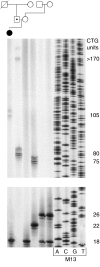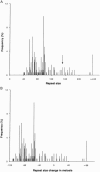High germinal instability of the (CTG)n at the SCA8 locus of both expanded and normal alleles
- PMID: 10712199
- PMCID: PMC1288166
- DOI: 10.1086/302827
High germinal instability of the (CTG)n at the SCA8 locus of both expanded and normal alleles
Abstract
The autosomal dominant spinocerebellar ataxias (SCAs) are a group of late-onset, neurodegenerative disorders for which 10 loci have been mapped (SCA1, SCA2, SCA4-SCA8, SCA10, MJD, and DRPLA). The mutant proteins have shown an expanded polyglutamine tract in SCA1, SCA2, MJD/SCA3, SCA6, SCA7, and DRPLA; a glycine-to-arginine substitution was found in SCA6 as well. Recently, an untranslated (CTG)n expansion on chromosome 13q was described as being the cause of SCA8. We have now (1) assessed the repeat size in a group of patients with ataxia and a large number of controls, (2) examined the intergenerational transmission of the repeat, and (3) estimated the instability of repeat size in the sperm of one patient and two healthy controls. Normal SCA8 chromosomes showed an apparently trimodal distribution, with classes of small (15-21 CTGs), intermediate (22-37 CTGs), and large (40-91 CTGs) alleles; large alleles accounted for only0.7% of all normal-size alleles. No expanded alleles (>/=100 CTGs) were found in controls. Expansion of the CTG tract was found in five families with ataxia; expanded alleles (all paternally transmitted) were characterized mostly by repeat-size contraction. There was a high germinal instability of both expanded and normal alleles: in one patient, the expanded allele (152 CTGs) had mostly contraction in size (often into the normal range); in the sperm of two normal controls, contractions were also more frequent, but occasional expansions into the upper limit of the normal size range were also seen. In conclusion, our results show (1) no overlapping between control (15-91) and pathogenic (100-152) alleles and (2) a high instability in spermatogenesis (both for expanded and normal alleles), suggesting a high mutational rate at the SCA8 locus.
Figures





Similar articles
-
An unstable trinucleotide-repeat region on chromosome 13 implicated in spinocerebellar ataxia: a common expansion locus.Am J Hum Genet. 2000 Mar;66(3):819-29. doi: 10.1086/302803. Am J Hum Genet. 2000. PMID: 10712198 Free PMC article.
-
Falls prevention interventions for community-dwelling older adults: systematic review and meta-analysis of benefits, harms, and patient values and preferences.Syst Rev. 2024 Nov 26;13(1):289. doi: 10.1186/s13643-024-02681-3. Syst Rev. 2024. PMID: 39593159 Free PMC article.
-
Depressing time: Waiting, melancholia, and the psychoanalytic practice of care.In: Kirtsoglou E, Simpson B, editors. The Time of Anthropology: Studies of Contemporary Chronopolitics. Abingdon: Routledge; 2020. Chapter 5. In: Kirtsoglou E, Simpson B, editors. The Time of Anthropology: Studies of Contemporary Chronopolitics. Abingdon: Routledge; 2020. Chapter 5. PMID: 36137063 Free Books & Documents. Review.
-
Defining the optimum strategy for identifying adults and children with coeliac disease: systematic review and economic modelling.Health Technol Assess. 2022 Oct;26(44):1-310. doi: 10.3310/ZUCE8371. Health Technol Assess. 2022. PMID: 36321689 Free PMC article.
-
The effectiveness of abstinence-based and harm reduction-based interventions in reducing problematic substance use in adults who are experiencing homelessness in high income countries: A systematic review and meta-analysis: A systematic review.Campbell Syst Rev. 2024 Apr 21;20(2):e1396. doi: 10.1002/cl2.1396. eCollection 2024 Jun. Campbell Syst Rev. 2024. PMID: 38645303 Free PMC article. Review.
Cited by
-
Genetic and clinical analyses of spinocerebellar ataxia type 8 in mainland China.J Neurol. 2019 Dec;266(12):2979-2986. doi: 10.1007/s00415-019-09519-2. Epub 2019 Aug 30. J Neurol. 2019. PMID: 31471687
-
CCG•CGG interruptions in high-penetrance SCA8 families increase RAN translation and protein toxicity.EMBO Mol Med. 2021 Nov 8;13(11):e14095. doi: 10.15252/emmm.202114095. Epub 2021 Oct 11. EMBO Mol Med. 2021. PMID: 34632710 Free PMC article.
-
Germline EGFR mutations in lung cancer (Review).Oncol Lett. 2023 May 16;26(1):282. doi: 10.3892/ol.2023.13868. eCollection 2023 Jul. Oncol Lett. 2023. PMID: 37274482 Free PMC article. Review.
-
Understanding what determines the frequency and pattern of human germline mutations.Nat Rev Genet. 2009 Jul;10(7):478-88. doi: 10.1038/nrg2529. Nat Rev Genet. 2009. PMID: 19488047 Free PMC article. Review.
-
Cognitive Changes in the Spinocerebellar Ataxias Due to Expanded Polyglutamine Tracts: A Survey of the Literature.Brain Sci. 2017 Jul 14;7(7):83. doi: 10.3390/brainsci7070083. Brain Sci. 2017. PMID: 28708110 Free PMC article. Review.
References
Electronic-Database Information
-
- Center for Medical Genetics database, http://www.marshmed.org/genetics
-
- Fondation Jean Dausset CEPH database, http://www.cephb.fr
-
- Généthon, http://www.genethon.fr
-
- Online Mendelian Inheritance in Man (OMIM), http://www.ncbi.nim.nih.gov/omim (for SCA8 [MIM 603680]) - PubMed
References
-
- Benomar A, Krols L, Stevanin G, Cancel G, LeGuern E, David G, Ouhabi H, et al (1995) The gene for autosomal dominant cerebellar ataxia with pigmentary macular dystrophy maps to chromosome 3p12-p21.1. Nat Genet 10:84–88 - PubMed
-
- Chong SS, McCall AE, Cota J, Subramony SH, Orr HT, Hughes MR, Zoghbi HY (1995) Gametic and somatic tissue-specific heterogeneity of the expanded SCA1 CAG repeat in spinocerebellar ataxia type 1. Nat Genet 10:344–350 - PubMed
-
- Chung M, Ranum LPW, Duvick LA, Servadio A, Zoghbi HY, Orr HT (1993) Evidence for a mechanism predisposing to intergenerational CAG repeat instability in spinocerebellar ataxia type 1. Nat Genet 5:254–258 - PubMed
Publication types
MeSH terms
LinkOut - more resources
Full Text Sources
Other Literature Sources
Research Materials

